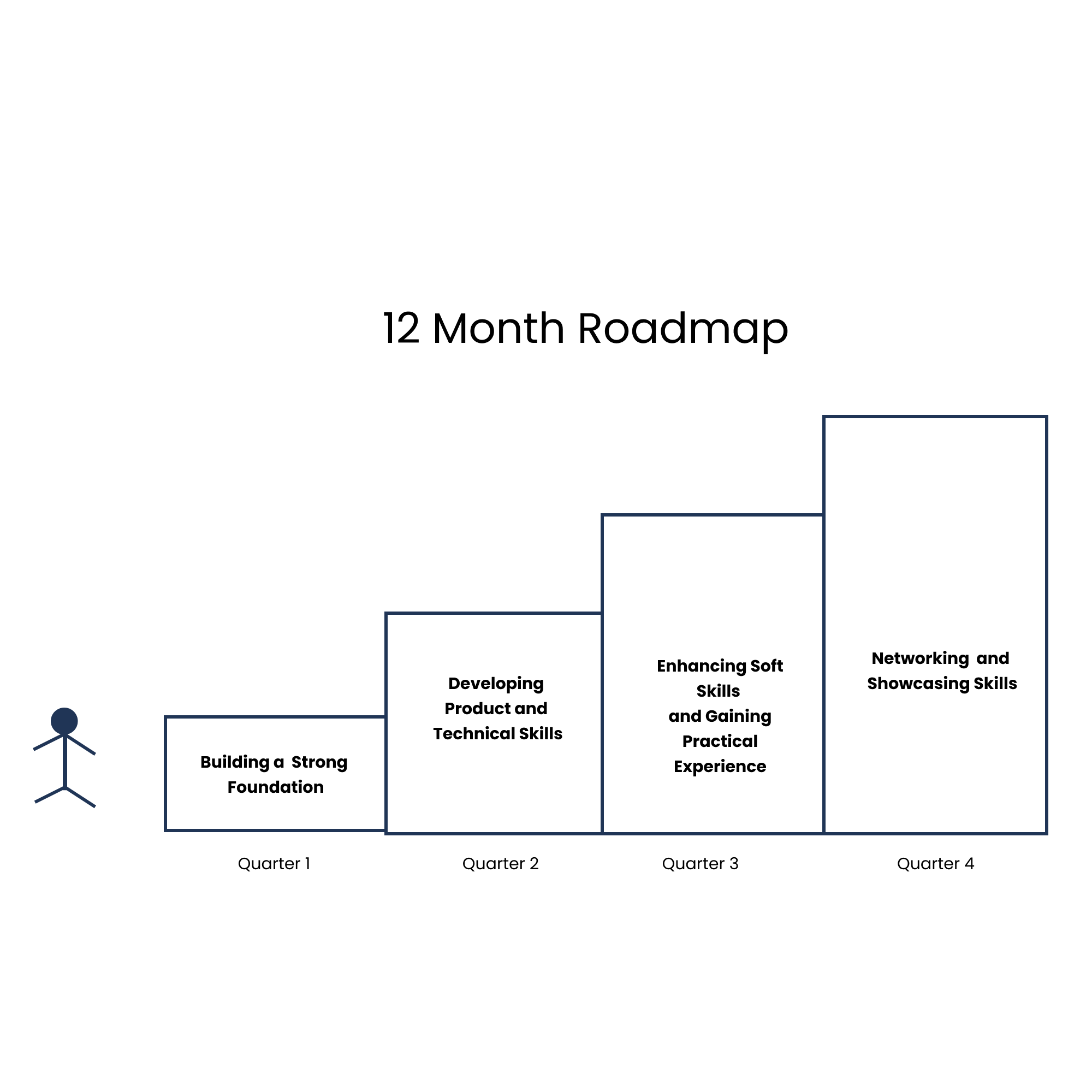
Are you eager to break into the world of product management and make a lasting impact on the tech industry? This comprehensive 12-month guide will provide you with a clear path to becoming a successful product manager. We’ll take you through the best books, courses, resources, and skills you need to master the art of product management. So buckle up, and let’s start your transformation into a rockstar product manager!
Breakdown of the 12-Month Plan
We’ve divided the learning journey into four quarterly milestones to make your path more manageable:
- First Quarter: Building a Strong Foundation
- Second Quarter: Developing Product and Technical Skills
- Third Quarter: Enhancing Soft Skills and Gaining Practical Experience
- Fourth Quarter: Networking and Showcasing Your Skills
First Quarter: Building a Strong Foundation
During the first three months, focus on understanding the fundamentals of product management and familiarizing yourself with industry best practices.
Books:
- “Inspired: How to Create Tech Products Customers Love” by Marty Cagan
- “The Lean Startup: How Today’s Entrepreneurs Use Continuous Innovation to Create Radically Successful Businesses” by Eric Ries
- “Cracking the PM Interview: How to Land a Product Manager Job in Technology” by Gayle Laakmann McDowell and Jackie Bavaro
Courses:
- Product Management 101 by Product School
- Introduction to Product Management by Coursera
Start networking with product managers through social media, meetups, or local events. Join online forums and communities such as Product Manager HQ, Mind the Product, and Product Coalition[8] to learn from experienced professionals and stay updated on industry trends.
Second Quarter: Developing Product and Technical Skills
In the second quarter, dive deeper into product management methodologies and sharpen your technical skills.
Books:
- “User Story Mapping: Discover the Whole Story, Build the Right Product” by Jeff Patton
- “The Design of Everyday Things” by Don Norman
- “Hooked: How to Build Habit-Forming Products” by Nir Eyal
Courses:
- Agile Product Management by Coursera
- Product Design and Development by edX
- Roadmapping and Product Strategy by Product School
Develop these technical skills:
- Data analysis: Learn how to work with data tools like Excel, SQL, and Google Analytics.
- UX/UI design: Understand the fundamentals of user experience and interface design.
- Basic programming: Familiarize yourself with programming languages like Python, JavaScript, or HTML/CSS.
Third Quarter: Enhancing Soft Skills and Gaining Practical Experience
Now that you have a strong understanding of product management and its technical aspects, focus on honing your soft skills and gaining practical experience.
Books:
- “The 5 Dysfunctions of a Team: A Leadership Fable” by Patrick Lencioni
- “Influence: The Psychology of Persuasion” by Robert B. Cialdini
- “Deep Work: Rules for Focused Success in a Distracted World” by Cal Newport
Courses:
- Improving Communication Skills by Coursera
- Effective Decision-Making: How to Make Better Decisions Under Uncertainty by FutureLearn
- Emotional Intelligence at Work by LinkedIn Learning
Develop these essential soft skills:
- Communication: Learn how to communicate effectively with team members, stakeholders, and customers.
- Leadership: Develop the ability to inspire, motivate, and guide your team toward a common goal. 3. Time management: Master prioritization, delegation, and planning to ensure timely product delivery.
To gain practical experience, consider the following options:
- Volunteer for product management-related tasks at your current job.
- Work on a side project or build your own product.
- Offer your skills to non-profits or startups on a part-time basis.
Document your experiences and build a portfolio showcasing your work. This will serve as tangible evidence of your skills and accomplishments.
Fourth Quarter: Networking and Showcasing Your Skills
In the final quarter, focus on expanding your network and showcasing your skills.
Books:
- “Never Eat Alone: And Other Secrets to Success, One Relationship at a Time” by Keith Ferrazzi
- “The Power of Habit: Why We Do What We Do in Life and Business” by Charles Duhigg
- “Show Your Work! 10 Ways to Share Your Creativity and Get Discovered” by Austin Kleon
Courses:
- Personal Branding Foundations by LinkedIn Learning
- Building Your Professional Network by Coursera
- The Art of Negotiation by edX
Attend industry events, conferences, and meetups to connect with professionals in the field. Engage in online discussions and contribute to the community by writing blog posts, sharing insights on social media, and participating in webinars or podcasts[38]. Leverage your network to explore job opportunities and gather insights on the hiring process.
As you prepare for interviews, practice answering common product management questions and tailor your portfolio to showcase your most relevant skills and experiences.
Conclusion
By diligently following this 12-month plan, you will be well-equipped to launch a successful career as a product manager. Remember that continuous learning and improvement are integral to staying ahead in this dynamic field. Keep honing your skills, expanding your network, and staying informed on industry trends to ensure long-term success in the world of product management.



